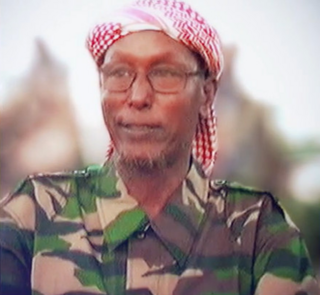
Kismayo is a port city in the southern Lower Juba province of Somalia. It is the commercial capital of the autonomous Jubaland region.
Muse Sudi Yalahow born Mogadishu was a Trade Minister in the Transitional Government of Ali Mohammed Ghedi. He was dismissed in June 2006 after ignoring government requests to halt fighting with the Islamic Courts Union militia.

The Battle of Jilib took place on the last day of 2006 during the Ethiopian invasion of Somalia. It was fought when Ethiopian National Defence Force (ENDF) troops and Transitional Federal Government (TFG) militia launched an offensive on the town of Jilib, held by the Islamic Courts Union (ICU).
The fall of Kismayo occurred on January 1, 2007, when the troops of Somalia's Transitional Federal Government (TFG) and Ethiopian forces entered the Somali city of Kismayo unopposed. It came after the Islamic Courts Union's forces faltered and fled in the Battle of Jilib, abandoning their final stronghold.
After two decades of violence and civil war and after the Transitional Federal Government (TFG) of Somalia captured Mogadishu and Kismayo, the TFG attempted to disarm the militias of the country in late 2006. According to the UN/World Bank's Joint Needs Assessment (JNA) coordination secretariat, "the total estimated number of militias [militia members] to be demobilized is 53,000." In 2005, they estimated that "there are 11–15,000 militia people controlling Mogadishu ."

Sheikh Hassan Abdullah Hersi al-Turki was a Somali Islamist who was a senior leader within al-Itihaad al-Islamiya (AIAI) and the Islamic Courts Union (ICU).
Kamboni is a town in the Badhaadhe district of Lower Juba region, Somalia, which lies on a peninsula near the border with Kenya. It is the southernmost town in Somalia. The tip of that peninsula is called Ras Kamboni. The town is located 274 kilometers south of Kismayo. The Town population is 79,000. American officials have said that it has served as a training camp for extremists with connections to Al-Qaeda; al-Sharq al-Awsat reported in May 1999 that al-Qaeda was installing sophisticated communications equipment in the camp.

The Battle of Ras Kamboni took place during the Ethiopian invasion of Somalia at the start of 2007. It began Ethiopian National Defence Force (ENDF) and Transitional Federal Government (TFG) militia backed by United States military air power launched an offensive on Ras Kamboni, a town near the Kenyan border which was the last major urban stronghold of the Islamic Courts Union (ICU) as it with withdrew deep into the south.
Yusuf Mohammed Siad Indhacade, aka "Inda'ade" is a Somali former Minister. In 2011 he was a General in the Somali National Army. He hails from the Ayr sub-clan, part of the Habar Gidir, which is a branch of the Hawiye clan. For a short period he was Somali Minister of Defence (Somalia).
Abdirashid Mohamed Hidig is a Somali political and a Member of Parliament in the Transitional Federal Parliament (TFP) of Somalia. There are 275 members of the Somali parliament. He was appointed on August 29, 2004, and will serve his term until 2009.

Abdirahman Mahmud Farah Janaqow is a Somali leader, and he was deputy chairman, and a member of the Islamic Courts Union of Somalia (ICU). He and other leaders signed a capitulation of Mogadishu on 27 December 2006 after military losses. However they continued military resistance to the south. Janaqaw was falsely reported to have been killed in a U.S. airstrike on 8 January 2007 in the Battle of Ras Kamboni. He is a member of the Murusade clan. He later served as the Minister of Justice for the Somali government.

Rear Admiral Bruce Nicholas Bromley Williams CBE is a retired Royal Navy officer.

The timeline of events in the War in Somalia during 2007 is set out below.

Hizbul Islam, also known as Hizbul Islaami, Hisbi Islam, or Hezb-ul Islam, was a Somali Islamist group formed after four Islamist groups merged to oppose the new Somali government of President Sheikh Sharif Ahmed. The four groups were: Hassan Aweys' the ARS-A, Jabhatul Islamiya, Hassan Abdullah Hersi al-Turki's the Mu'askar Ras Kamboni and Muaskar Anole, the Marehan clan's Militia and Harti clan's militia. These groups previously took part in the fighting against the Ethiopian occupation of Somalia.
Muaskar Anole also known as Mu'askar Anole, Mucaskarka Caanoole, Mucaskarka al-Furqan, al-Furqan Camp or al-Furqan Forces was an Islamist militia in Somalia. The group participated in the 2006–2009 insurgency against Ethiopia and in January 2009 merged with the Asmara based wing of the Alliance for the Re-liberation of Somalia, led by Sheikh Hassan Dahir Aweys, the Ras Kamboni Brigade, led by Sheikh Hassan Abdullah Hersi al-Turki and Jabhatul Islamiya to form Hizbul Islam which became the second most powerful insurgent group in Somalia which continued fighting the TFG and AMISOM peacekeepers, after Ethiopian withdrawal. Little is known about the group.

The Ras Kamboni Brigades also known as the Ras Kamboni Brigade, Muaskar Ras Kamboni or Mu'askar Ras Kamboni was an Islamist insurgent group active in Somalia, which took part in the anti-Ethiopian insurgency and later in the insurgency against the new Transitional Federal Government of Sheikh Sharif Ahmed. It was founded by Hassan Abdullah Hersi al-Turki, who was a commander of the Islamic Courts Union and the commander of its predecessor Itihaad al Islamiyah. In January 2009, after the Ethiopian withdrawal they merged with the Asmara-based wing of the Alliance for the Re-liberation of Somalia, led by Sheikh Hassan Dahir Aweys, Jabhatul Islamiya, led by Sheikh Mohamed Ibrahim Hayle and Muaskar Anole to form Hizbul Islam and continue the war against the TFG. During the 2009 Battle of Mogadishu, where in Hizbul Islam took part, Hassan Turki led a group of fighters from the Ras Kamboni Brigade from Kisimayo to Mogadishu as reinforcements, to join the battle.
The Baraawe raid, code named Operation Celestial Balance, was a helicopter assault by United States Special Operations Forces against the al-Qaeda-linked terrorist Saleh Ali Saleh Nabhan and associated al-Shabaab militants near the town of Baraawe in southern Somalia.
Battle of Kismayo may refer to:

The Raskamboni Movement is a jihadist Islamic movement led by Sheikh Ahmed Madobe, the current president of the Jubaland state in southern Somalia. After fighting with Al-Shabaab they managed to capture Kismayo with the help of Kenya.
On 11 December 2024, heavy fighting erupted between Somali Armed Forces and Jubaland regional forces in the Marnani area near Ras Kamboni. After Federal Government of Somalia deployed Somali National Army from Mogadishu to the region in an attempt to throw out President Ahmed Madobe from the Office.









